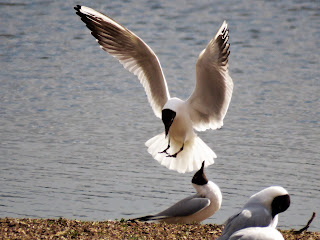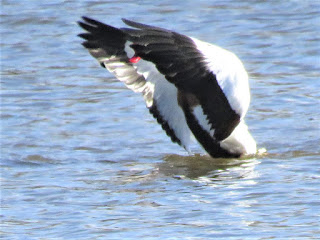On a fine and only slightly breezy morning a visit to the SOS Venus Pool was in order. Plenty of bird activity proving that I was, at times, pushing my camera rather beyond its capabilities to pick out and stay locked on to flying birds. Unless I am willing to upgrade and lug a heavy SLR-type camera around we will all have to put up with a bit of blurring at times I am afraid.
Several Mute Swans here – we need a pair to settle in to Priorslee at the moment. Here one tucks up its undercarriage as it goes for a fly.
And circles past, probably headed for the fields alongside the River Severn.
Another trio leaves. The middle bird has a greyer bill indicating it is an immature.
Greylag Geese overhead, probably a pair: the larger, lower bird likely the male.
What seems to be a pair of Canada Geese flying by – the smaller female in front.
A birding magazines used to run a competition showing bad bird photos challenging readers to identify the species involved. Here is my contribution. Though it is not too hard ....
Ah! all is revealed as this drake Shelduck touches down.
And another drake in flight. With five birds present there was a lot of flying about.
Here canted over to show the upper wing markings.
And another comes in to land.
And splash-down.
My favourite: a drake Gadwall. Here showing full breeding plumage with fully grown buffy scapulars.
A trio of Gadwall departing: two drakes on the left with a duck on the right. Note the very different tail markings as well as the small but obvious white speculum.
Here a pair : the chestnut in the wing of the drake is very apparent.
A drake Wigeon calling – a far-carrying ‘wee-oo’ note. Interestingly it looks as if this bird has managed to bend its lower mandible – or is it a trick of the light?
This drake in good light. Note the ‘tail’ on this bird: it is easy to see that it is related to the Pintail.
A rather odd-looking duck Wigeon. It is likely a first-year bird with rather subdued orange flanks and obvious white fringes to some of the feathers. No ideas about the white spot behind the eye, an area which is usually darker than the face.
Two pairs of Wigeon in flight, the drakes with the white panels in the wings. Note the pointed tails and the rather pointed wings, often angled back in fast flight. Enables distant flocks to be identified.
Great light on this duck Shoveler. The blue of the forewing is just about visible when the wings are folded.
On the flying bird the blue forewing is very obvious as is the green speculum that runs the full-length of the secondaries.
And here a duck Shoveler.
Seen departing is this adult Cormorant showing its white head plumes and the white thigh-patch. The bare skin at the base of the bill becomes brighter as well in the breeding season.
Here the white on the thigh is rather more evident.
Several noisy Oystercatchers were present: here one flies by.
A rare opportunity to grab a shot of a Snipe in flight.
So I welcomed two of them together.
And again.
I know it is not very sharp but could not resist showing the angle that this Snipe is adopting as it prepares to land.
Two Moorhens apparently taking part in a dance competition.
A single Moorhen beautifully lit.
A Coot walking on water.
No it is not running backwards: it is doing what Coots like doing – chasing. Note that the wings are paler than you might expect and that the secondaries are tipped white.
Chasing like this.
A study in black (Coot) and white (Black-headed Gull).
Many Black-headed Gulls still about. Many of them first-year birds – as are these two ...
... and this one with a crick in its neck.
A first-year flies by.
At this time of year first-year birds seem keen to pick up sticks and fly around with them, probably ‘training’ for nest building next year. Often any bird that picks up a stick is chased by others. Here two birds pick up their own sticks.
The Black-headed Gull formation flying team. Here four of seven are adults with black hoods.
These six Black-headed Gulls are not in quite as neat a formation.
Six Lapwings compete for the formation flying award.
A passing Wood Pigeon shows the white shafts in the primaries.
Seem to have caught this passing Magpie while it is ‘blinking’. Many bird species have an extra eyelid, the nictating membrane. This is translucent, often showing pale or even, as here, white. It allows them to keep the eye moist while maintaining full sight.
A ‘compare and contrast’ showing the size difference between the adult Lapwing and the male Pied Wagtail.
The same male Pied Wagtail being dwarfed and ignored by the feeding pair of Gadwall.
A trio of Hebridean Sheep are kept here to mow some areas of vegetation. Whether these are ‘pre’ Hebridean’ I am unsure as the web tells me that this species normally has two pairs of horns.
(Ed Wilson)

























































































